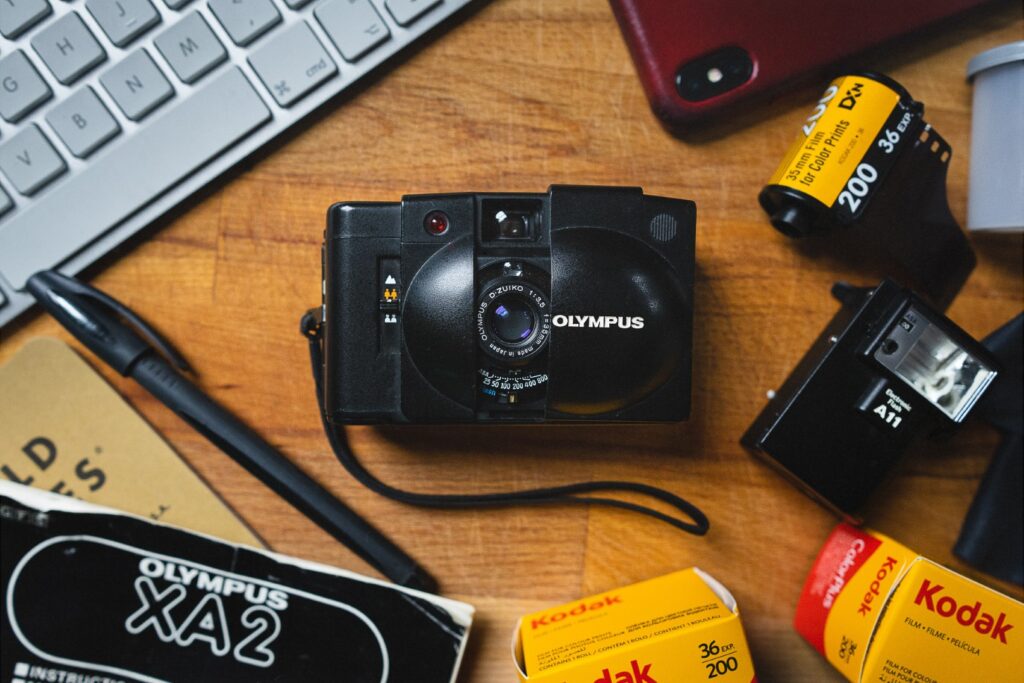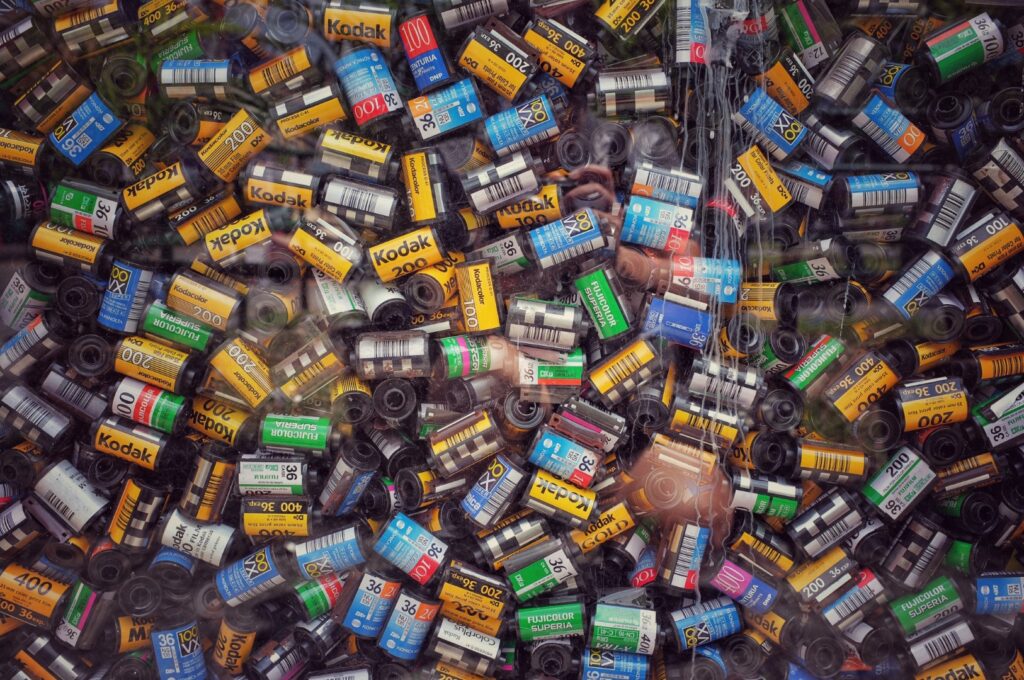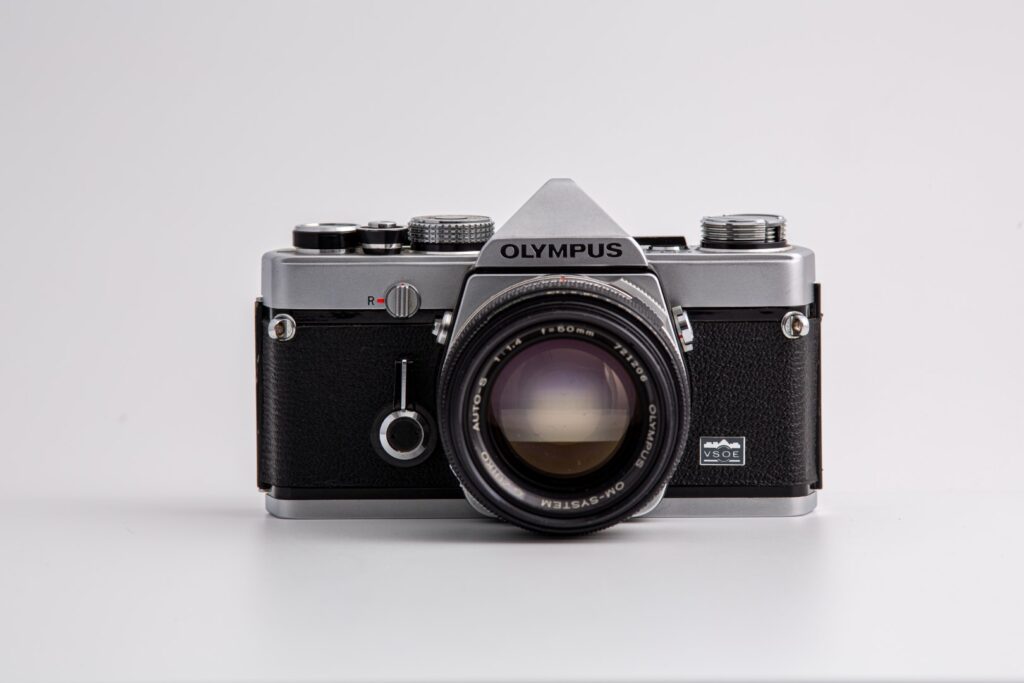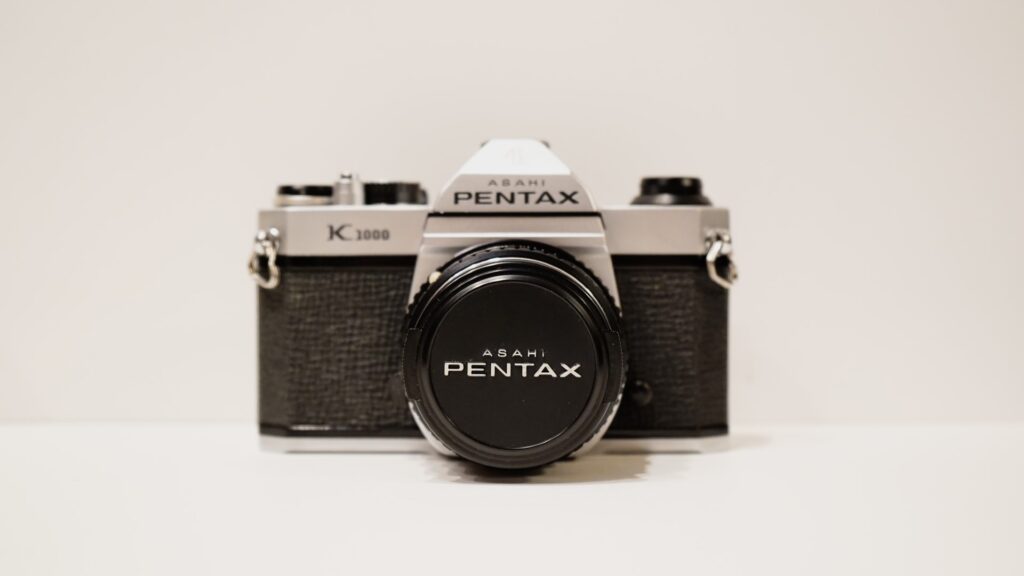In 1980, Olympus introduced the XA2, a simplified version of its predecessor, the XA. This camera catered to photographers seeking an uncomplicated, reliable tool for capturing their world. Equipped with zone focusing and a programmed exposure system, the XA2 struck a balance between ease-of-use and high-quality output.
The XA2 features a sturdy Zuiko 35mm f/3.5 lens, composed of four elements in four groups. Paired with a CdS exposure sensor, this setup affords a shutter speed range of 2 seconds to 1/750. The minimum focusing distance of the lens is 3 feet (or 0.9 meters), allowing for a broad range of photographic possibilities.
Additionally, the XA2 supports a film speed range from ASA 25 to 800, making it adaptable to a variety of lighting situations. Alongside its functionality, the XA2 was made available in a limited supply of white, red, and blue variants. With its compact form and straightforward operation, the XA2 is a reliable choice for photographers. However, the abundance of film options can make it challenging to choose the best film for your camera. This guide aims to clarify the best film choices for your Olympus XA2. Let’s explore together.
Film Sizes and which one does the Olympus XA2 use?
In the realm of photography, film size is a key factor that determines image quality, convenience, and overall cost. The most common sizes are 35mm, 120 (medium format), and large format films, each with its unique advantages and drawbacks.
35mm film, the most popular and widely available, is known for its compactness and ease of use. It typically offers 24 or 36 exposures per roll and has an aspect ratio of 3:2. Its small size can lead to grainier images when enlarged, but with modern film and professional scanning, this is less of an issue than it once was.
120 film, or medium format, provides larger negatives, which means more detail and less grain. However, medium format cameras and film are typically more expensive and less portable than their 35mm counterparts.
Large format film offers the highest quality in terms of resolution and detail, given the size of the negatives. Yet, the cameras and film are costly, bulky, and require a certain level of expertise to handle properly.
Now, let’s focus on the Olympus XA2. This camera uses 35mm film, which strikes a balance between quality and convenience. Given the camera’s compact size, automatic exposure, and zone focusing system, the 35mm film complements these features perfectly. Its relatively low cost and widespread availability make it an excellent choice for everyday use, while the variety of film stocks available in 35mm allows photographers to experiment with different styles and conditions. For the Olympus XA2 user, 35mm film not only keeps the camera portable and user-friendly but also opens up a vast world of creative potential.
The Different Types of Film Stocks
The choice of film stock can greatly influence the mood, texture, and overall aesthetic of your photos. The three main types are black and white film, color negative film, and slide film. Let’s discuss each type and see how they work with the Olympus XA2.
Black and White Film
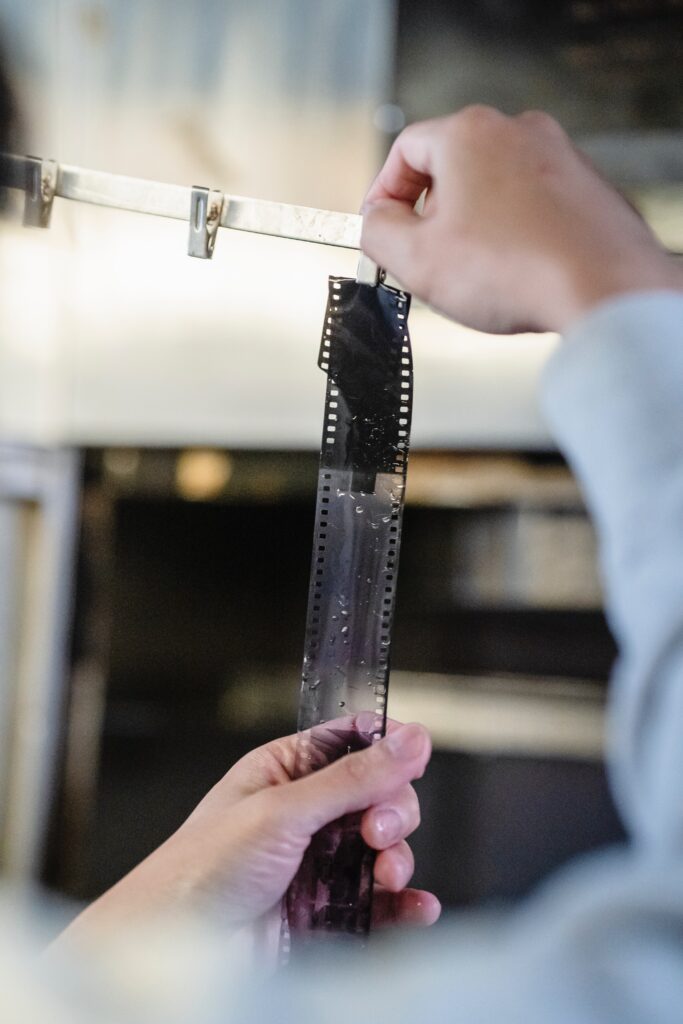
Black and white film captures images in various shades of grey, from pure white to deep black. This film stock is perfect for emphasizing contrast, texture, and patterns, often lending a timeless, classic feel to photos. Moreover, it typically has a wider exposure latitude, forgiving slight exposure mistakes. Black and white film is generally less expensive than color film, and it can be developed at home, offering photographers more control over the final image. However, it might not be as readily available as color film, depending on your location.
For Olympus XA2 users, black and white film can provide an excellent tool for capturing street scenes, portraits, and urban landscapes. Given the XA2’s compact size and ease of use, it pairs well with the spontaneity and creative potential of black and white photography.
Color Negative Film
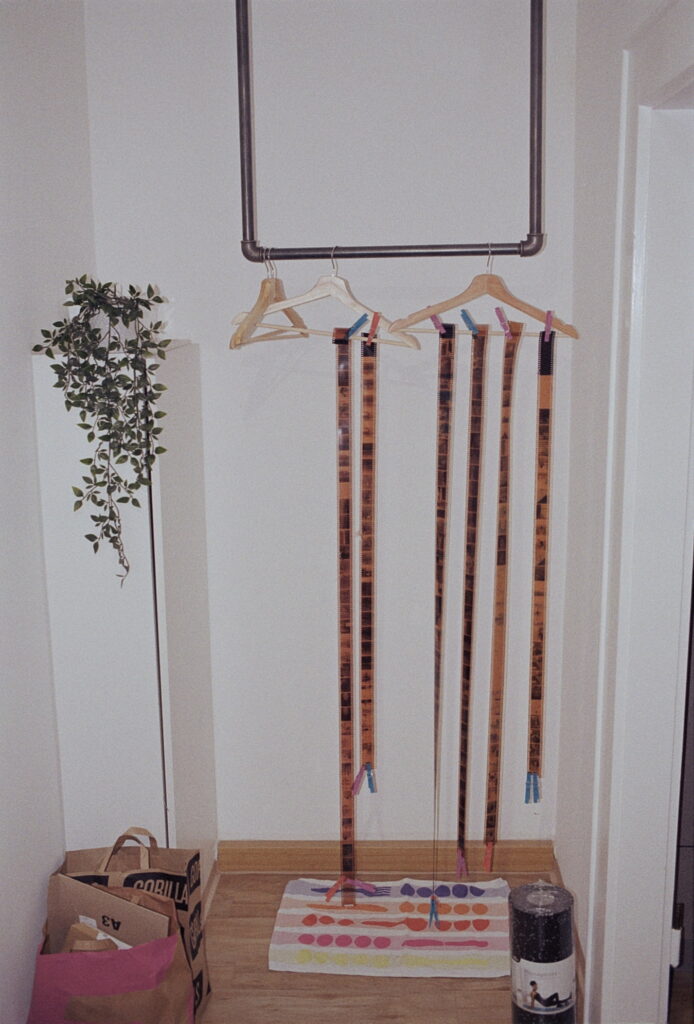
Color negative film, the most prevalent type of color film, is well-suited for capturing a wide range of colors and has good latitude when it comes to exposure, making it forgiving for minor exposure errors. It’s versatile and can be used in an array of scenarios, from portrait photography to landscape shots and everyday life moments.
Though developing color negatives might be more complex than black and white film, the results can be worth the effort. In terms of cost, color negative film is generally more expensive than black and white film, though prices vary depending on the specific film stock and place of purchase. If you’re using an Olympus XA2, pairing it with color negative film allows you to create vibrant images in diverse lighting situations with ease, thanks to the camera’s automatic exposure and wide film speed range.
If you’re interested in exploring more options, gaining inspiration, checking sample images, and comparing prices, our article on all currently available 35mm color negative film stocks is a great resource. It provides an extensive overview and detailed information about each film stock, helping you choose the one that best suits your photography style and needs.
Slide Film
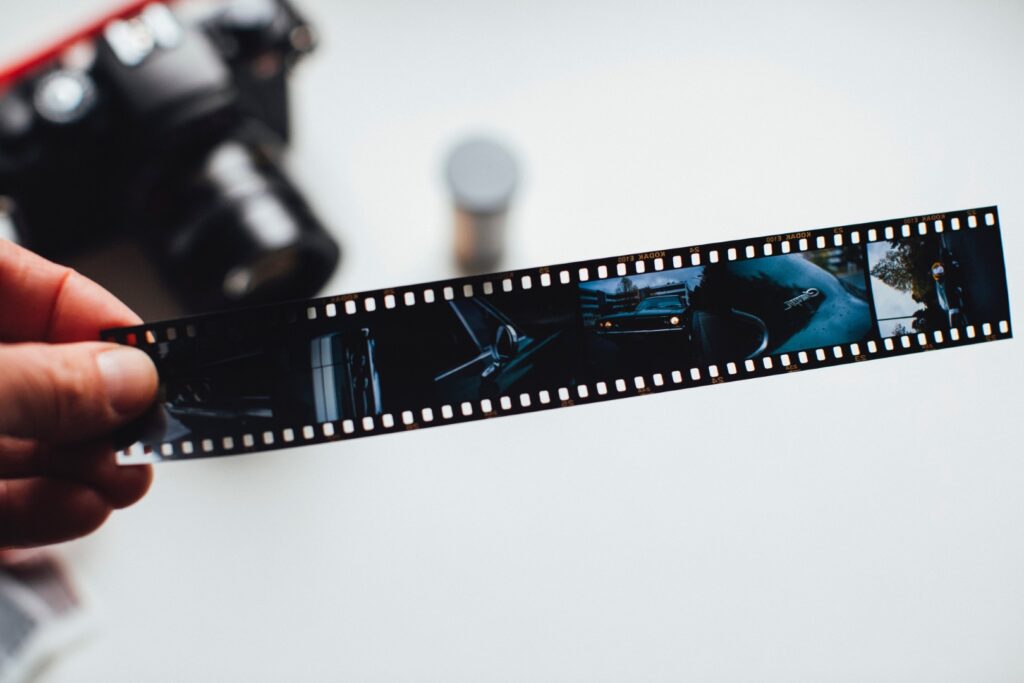
Slide film, or reversal film, produces positive images that are viewed or projected directly. It is known for its fine grain, sharpness, and vibrant, saturated colors. However, slide film has a narrower exposure latitude, meaning it’s less forgiving of exposure mistakes.
While slide film is typically more expensive than both black and white and color negative film, and requires special E-6 processing, it is prized by photographers for its color rendition and high resolution.
When used in the Olympus XA2, slide film can deliver stunning, vibrant images. However, given the camera’s automatic exposure, it may be more challenging to use than the other film types due to the exposure precision that slide film requires. It’s best suited for Olympus XA2 users who are looking to experiment and push their skills.
Considerations When Choosing a Film for Your Olympus XA2
Choosing a film for your Olympus XA2 involves more than just deciding between black and white, color negative, or slide film. It’s essential to understand the concept of film speed, the aesthetic qualities you’re seeking, and the practical considerations of developing and scanning.
Film Speed
Film speed, denoted as ISO, is a measure of a film’s sensitivity to light. The Olympus XA2 accommodates a film speed range from ASA 25 to 800, offering flexibility for various lighting situations. Lower ISO films (such as 25, 50, or 100) are less sensitive to light, producing fine grain and high detail. These are perfect for bright outdoor conditions. Higher ISO films (like 400, 800), on the other hand, are more light-sensitive, better suited for low-light situations, indoors or dusk scenes. However, they generate more grain in the image.
For everyday, versatile shooting, 400 ISO film often serves as a good starting point, able to handle a mix of lighting situations reasonably well.
Aesthetic Qualities of the Film Stock
The aesthetic impact of a film stock shouldn’t be overlooked. Each film has unique color reproduction, contrast, grain structure, and saturation. For instance, some films yield warm tones, while others lean towards cooler hues. Some create high contrast images, while others provide a more subdued, softer look. Therefore, choose a film that matches the aesthetic you’re aiming to achieve in your photos. Experimentation is key here, and thankfully, 35mm film offers a plethora of options to explore.
Developing and Scanning Film
After shooting, you’ll need to develop and scan your film. You have two main options: home developing and scanning, or using a professional lab.
Home developing can be more cost-effective in the long run and offers a greater degree of control over the final result. However, it requires an initial investment in equipment and chemicals and needs some practice to master. Black and white film is easier to develop at home, while color film, particularly slide film, can be more challenging.
Lab developing and scanning, on the other hand, requires less effort on your part. The lab handles the process, ensuring consistency and quality. However, this option can be more expensive, especially if you shoot frequently.
Choosing between these options will depend on your budget, time, and interest in the hands-on aspect of film photography. Remember, there’s no right or wrong choice; it’s all about what works best for you.
Top Film Choices for Olympus XA2
Choosing a film stock that complements the Olympus XA2’s features and qualities can further enhance your photography experience. Here are some top picks for color, black and white, and slide films that work well with the XA2.
Color Films
Kodak Portra 400: Kodak Portra 400 has earned its place in the hearts of many photographers for its exceptional versatility and superior color reproduction. With its unique ability to capture a wide range of skin tones accurately, it’s become the go-to for portrait and social documentary photography. Its fine grain and robustness against varying exposure make it forgiving for beginners and reliable for seasoned photographers. Pairing Portra 400 with the XA2, you can trust the camera’s automatic exposure system to yield consistently beautiful results, whether you’re capturing portraits or everyday shots. Check current prices here.
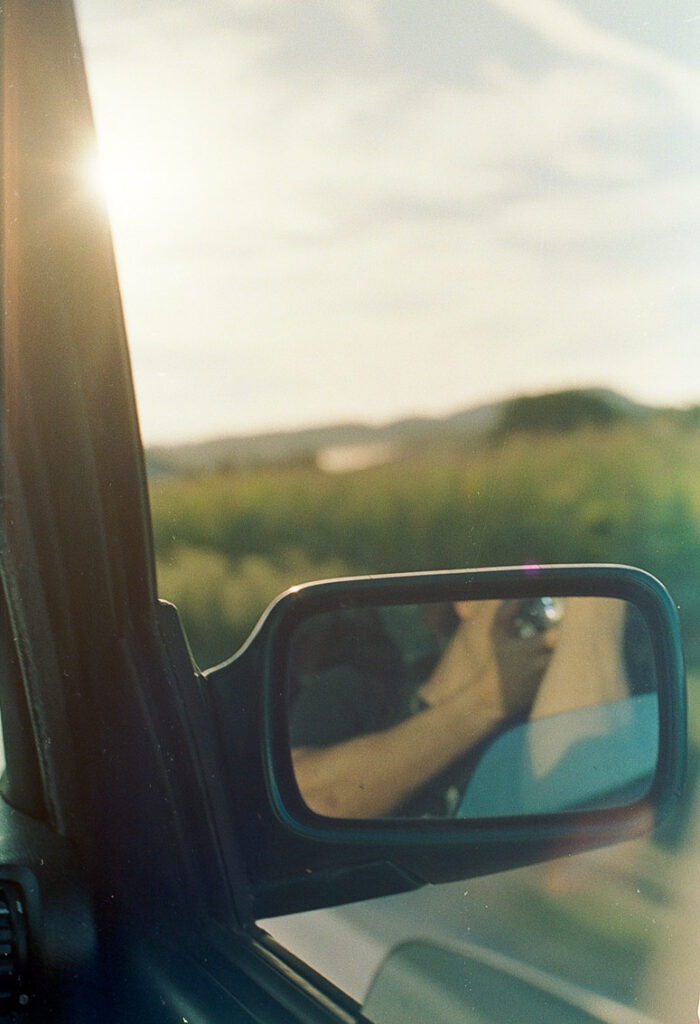
Kodak Ektar 100: This film offers the finest, smoothest grain of any color negative film available today. Ideal for scanning, it boasts ultra-high color saturation, delivering bold, vibrant colors. Ektar 100 is a superb choice for commercial photographers and advanced amateurs for applications such as nature, travel, and product photography. The slower speed of this film can showcase the best of the XA2’s sharp Zuiko 35mm lens, rendering detailed, strikingly colorful images. The XA2’s ability to handle slower films can take your sunny outdoor and brightly lit photography to the next level. Check current prices here.
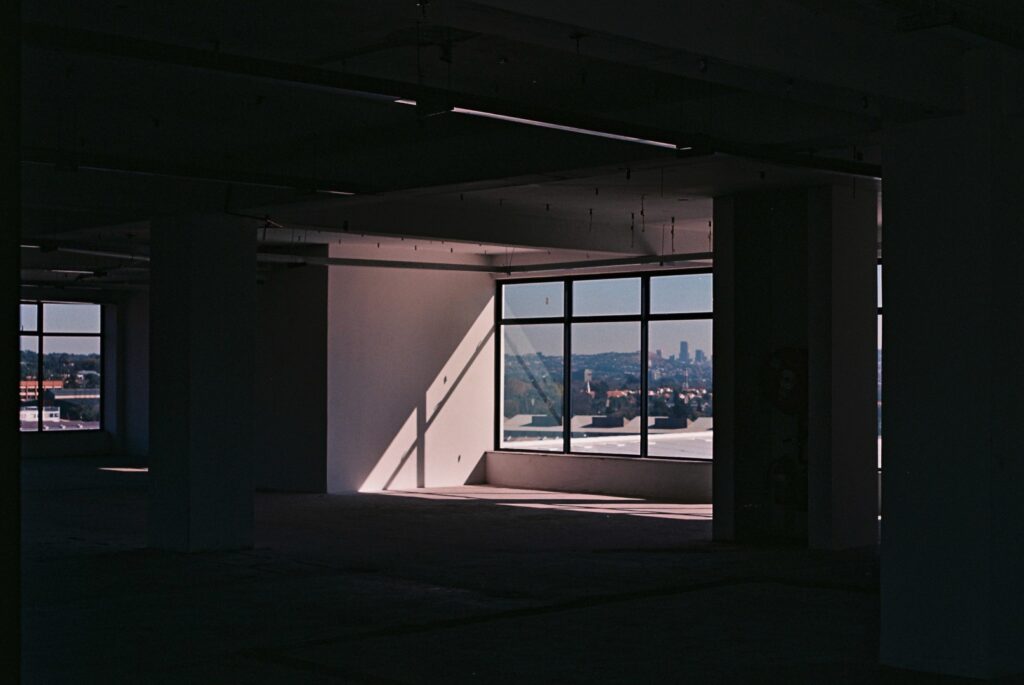
Lomography Color Negative 800: This film is known for its excellent low light performance. It’s a high-speed film that offers a unique aesthetic with vibrant, yet sometimes unpredictable colors and pronounced grain, perfect for those looking to inject some artistic flair into their photos. This film’s flexibility and the Olympus XA2’s compact design and automated exposure make a great combination for street photography, night scenes, or indoor settings. It enables you to continue shooting even as the light fades, extending your photography sessions into the twilight hours. Check current prices here.
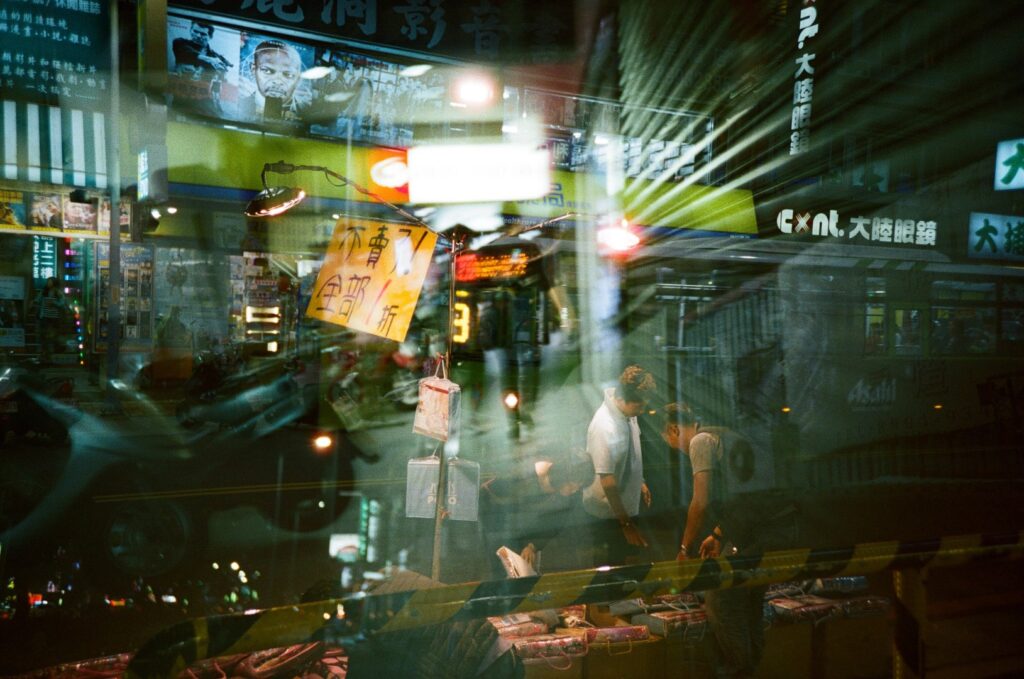
Again, this selection is only a small part of the plethora of color film stocks available. For a more comprehensive view of what’s available, with in-depth descriptions and sample images, don’t forget to check our extensive guide on all currently available 35mm color negative film stocks. This resource is your gateway to a world of color film options, helping you choose the perfect film for your Olympus XA2 and your unique style of photography.
Black and White Films
Kodak Tri-X 400: An iconic name in the world of black and white photography, Kodak Tri-X 400 has been a mainstay for photojournalists and documentary photographers for over half a century. Noted for its rich contrast and excellent tone reproduction, it handles diverse lighting conditions admirably, making it a flexible choice for those exploring the world through their XA2 viewfinder. Whether capturing the dramatic interplay of light and shadow in street scenes, or exploring patterns and textures in your environment, the Tri-X 400 in your XA2 can truly make your vision come alive. Check current prices here.
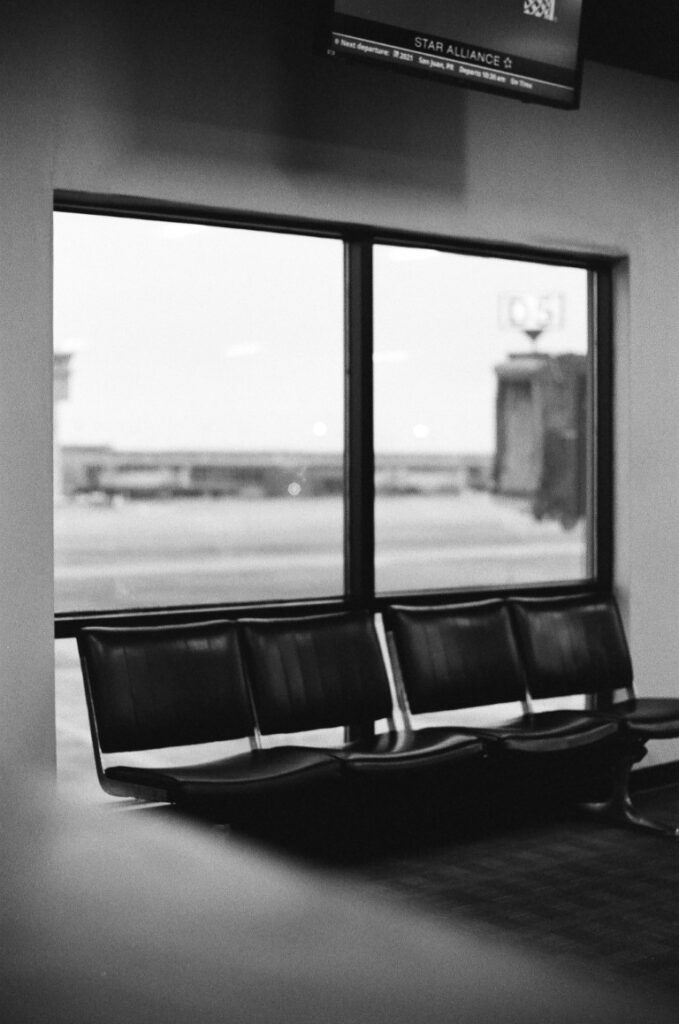
Ilford HP5 Plus 400: A stalwart of Ilford’s black and white film line-up, HP5 Plus 400 offers photographers a forgiving latitude, making it an excellent film for those still learning their craft. It renders images with medium contrast and grain, producing a classic look that echoes back to the golden age of photography. As an added advantage, the XA2’s automatic exposure pairs well with this film, effortlessly delivering a timeless aesthetic to your images. This film’s versatility and ease of use make it an excellent choice for those starting out with black and white photography or those who prefer a traditional aesthetic. Check current prices here.
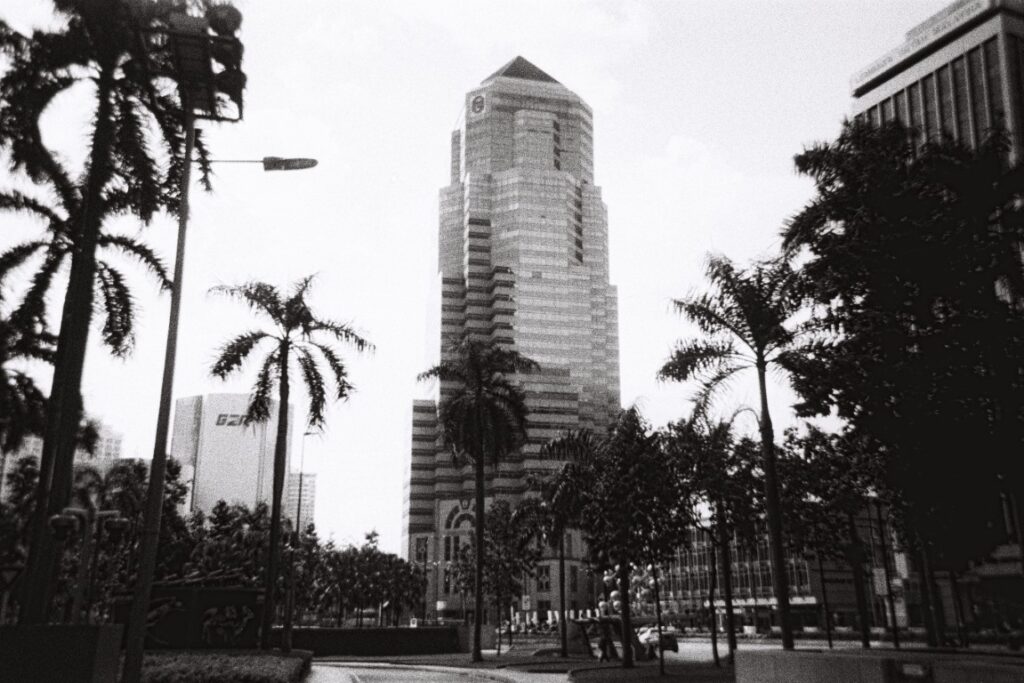
Fomapan 200 Creative: As a budget-friendly yet quality film, Fomapan 200 Creative proves that excellent results don’t always need to come at a high cost. This film is known for its fine grain, good resolution, and high acutance, contributing to clear and detailed images. It offers a traditional black and white aesthetic, well-suited for a variety of shooting situations. Paired with the XA2, this film can produce sharp and clear images with a touch of the classic film feel, making it an ideal choice for both beginners and seasoned photographers alike. Check current prices here.

Slide Films
Fujifilm Velvia 50: Often the first choice for landscape photographers and those seeking to capture the vivacious beauty of nature, Fujifilm Velvia 50 is famed for its extraordinarily high color saturation and contrast. These qualities can bring out an almost surreal depth and vibrancy in your photos, creating images that are not just seen, but felt. The lower ISO rating means it performs best in abundant light. Despite this, with the XA2’s pocketable size, it’s always handy for those spontaneous moments of photographic inspiration under the sun. Check current prices here.

Kodak Ektachrome E100: Revived from Kodak’s iconic line of color reversal films, Ektachrome E100 is known for its incredibly fine grain, vivid yet accurate colors, and excellent sharpness. This film provides a moderate level of contrast and color saturation, resulting in a natural and clean look that is versatile enough to handle a broad array of subjects. However, as with all slide films, Ektachrome requires precise exposure to showcase its best. The XA2’s automatic exposure system will generally serve you well, but do pay attention to your lighting for optimal results. Check current prices here.

Slide films provide a unique aesthetic that’s different from the more common color negatives and black and white films, offering a brilliant, vibrant look straight out of the camera. The distinctive quality of slide film can lend a unique dimension to your photography, helping your creative expression stand out. However, keep in mind that slide film requires more careful handling, both during shooting and processing. The added effort can be well worth it for the distinctive and vibrant results that slide film is known for.
Budget-Friendly Film Alternatives for Olympus XA2
Kodak ColorPlus 200: Kodak ColorPlus 200 offers quality at an unbeatable price. This color negative film is known for its decent color reproduction and fine grain. It’s well-suited for general-purpose photography and performs optimally under good lighting conditions. Given the Olympus XA2’s daylight-synched auto-exposure, this film can be a cost-effective companion for your everyday photography adventures. Check current prices here.
Fomapan 400 Action: For those interested in experimenting with black and white photography on a budget, Fomapan 400 Action is a viable option. This film offers a higher ISO at a lower price, making it a flexible choice for different lighting conditions. Although the grain is more pronounced than some more expensive films, it can add a unique, vintage character to your images. Fomapan 400 Action, combined with the XA2’s automatic exposure system, can be an excellent way to enter the world of black and white photography without causing strain on your wallet. Check current prices here.
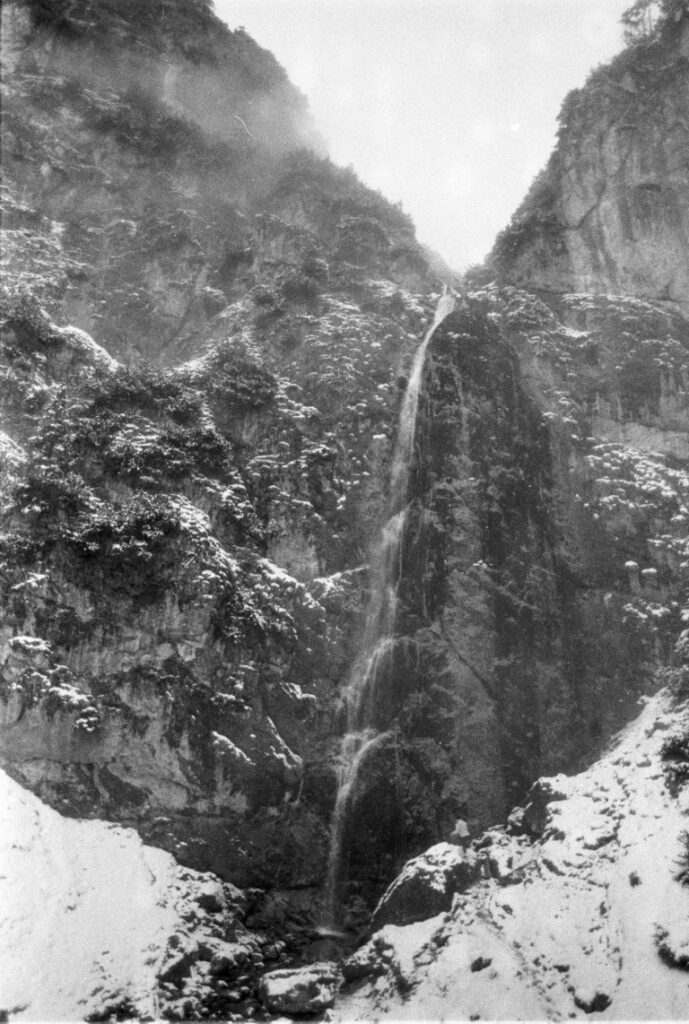
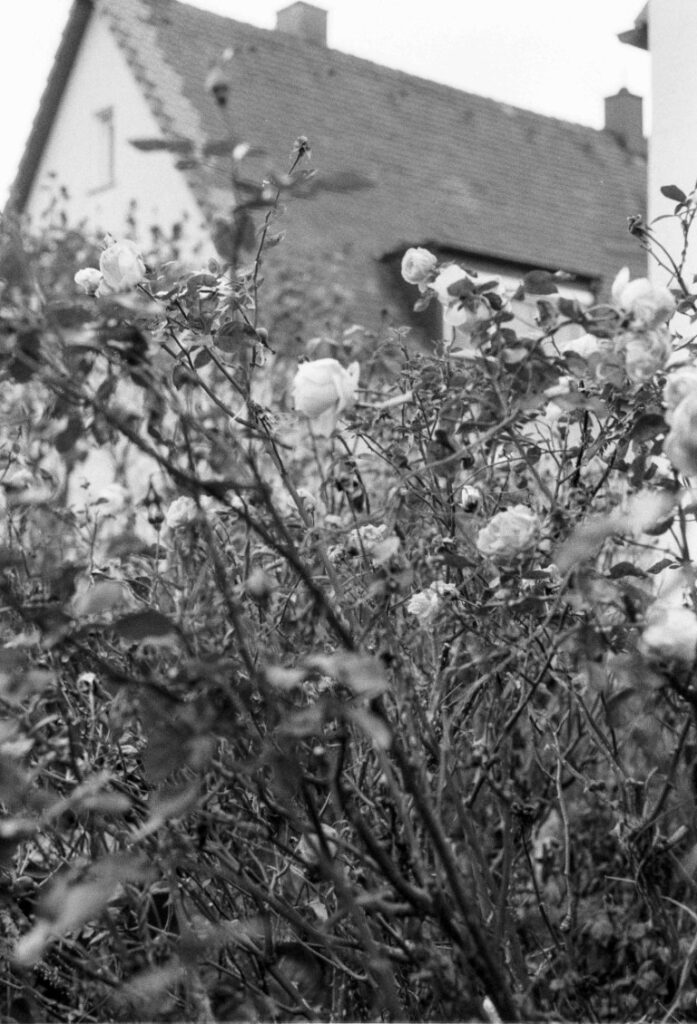
For more Foma 400 images, check out my Fomapan 400 Flickr album. We’ve captured our firsthand experiences with Fomapan 400 in this YouTube video, covering everything from shooting to self-developing the film. Take a look for a comprehensive look.
Where to Buy Film for the Olympus XA2
When it comes to buying film for your Olympus XA2, there are several avenues to consider. The most suitable will depend on your personal preferences, convenience, and the specific film stocks you’re after.
- eBay: eBay is an extensive online marketplace where you can find just about any type of film, from the most popular brands to niche or discontinued options. However, always check seller ratings and reviews before purchasing to ensure reliability.
- Amazon: Amazon carries a broad selection of film stocks and often provides quick shipping. They sell directly as well as through third-party sellers, so prices can vary.
- Specialized Online Retailers: Websites like B&H, Adorama, and KEH are dedicated to photography equipment and often carry a wide variety of film types. They’re known for their reliable service, and they frequently have sales or special offers.
- Local Photography or Camera Stores: Your local photography or camera store is a good place to look. Shopping locally supports small businesses, and staff are often knowledgeable and can give helpful advice. Availability will depend on the store, so it may be worth calling ahead to check if they have what you’re looking for.
Remember, each of these options will offer different brands, film speeds, and prices, so it’s worth exploring multiple sources to find exactly what you need for your Olympus XA2.
Frequently Asked Questions about Using Film in Olympus XA2

In the following section, we address some frequently asked questions about using film with the Olympus XA2. Whether you’re curious about how to load film, or uncertain about which film speed is optimal for different lighting conditions, we’ve got you covered.
How does the Olympus XA2’s automatic exposure system affect my choice of film?
The Olympus XA2’s automatic exposure system is designed to determine the appropriate shutter speed based on ambient light conditions and the manually set ISO value. It’s important to note that the XA2 does not read DX codes, so you’ll need to set the film speed manually. This versatility allows for the use of a wide range of film speeds, from slower (low ISO) to faster (high ISO) films. For shooting in challenging light conditions or capturing fast-moving subjects, a higher ISO film can be beneficial, ensuring that the XA2’s exposure system can sufficiently capture the scene.
How do I account for the Olympus XA2’s fixed focal length when choosing a film?
The XA2 has a fixed 35mm focal length, which is a versatile choice for a range of situations, including street photography, landscapes, and general-purpose shooting. When choosing a film, consider the type of photography you’ll be doing. If you’re planning on capturing landscapes or city scenes, a film known for its color reproduction might be beneficial. If you’ll be doing street or documentary work, a high-speed black and white film might be more appropriate.
What film speed is ideal for different lighting conditions with the Olympus XA2?
The film speed you choose depends on the lighting conditions. For bright, sunny days, a film with a lower ISO, like 100 or 200, should work well. For overcast days or indoor photography, a higher ISO, like 400 or 800, might be a better choice. Remember that the Olympus XA2 has an automatic exposure system and can handle a wide range of film speeds, from ISO 25 to 800.
How does the Olympus XA2 perform with black and white versus color film?
The Olympus XA2 performs well with both black and white and color films. The choice between the two often comes down to personal preference and the type of photography you plan to do. Black and white film can lend a timeless, classic feel to your images, and is often favored for street and portrait photography. Color film, on the other hand, is great for capturing vibrant landscapes, city scenes, or any situation where color plays a significant role.
Can I use expired film with my Olympus XA2?
Yes, you can use expired film in your Olympus XA2. However, keep in mind that as film ages, the colors can shift, contrast can decrease, and grain can increase. The effects are often unpredictable, which some photographers use for creative effect. However, for more consistent and predictable results, fresh film is generally recommended.

